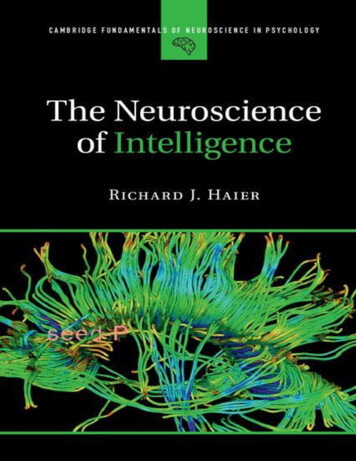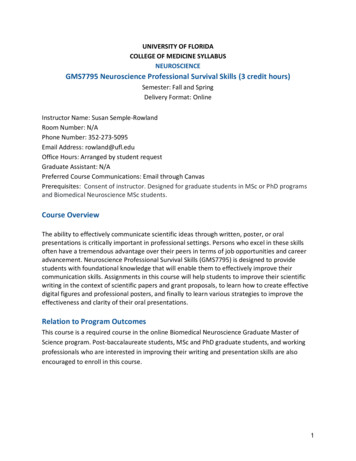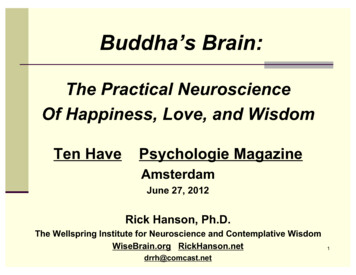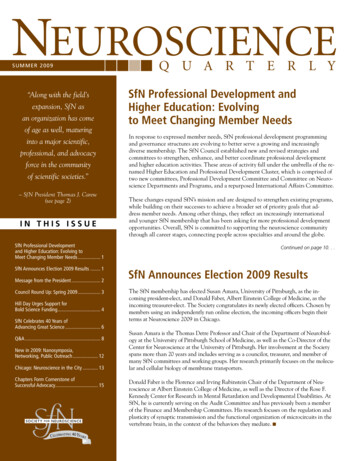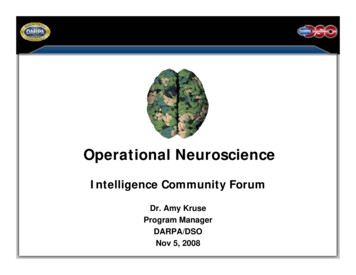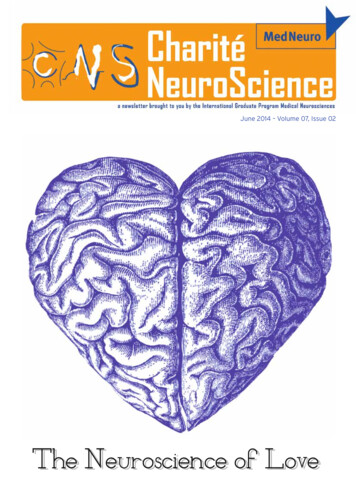
Transcription
CNSNewsletter June 2014Topic1June 2014 – Volume 07, Issue 02The Neuroscience of Love
2EditorialPage 3-19CNSNewsletter June 2014FOCUSThe Evolution of LoveLove is ChemistryThe Course of True Love Never Did Run SmoothBrain Activity in LoveRules of AttractionOf Mothers, Methylation and ModernityMono or Poly – Which is our Nature?Take Care, Give LoveIn Search of Cupid – ErotomaniaStockholm Syndrome: A not-quite love storyAltruism or Do a Good Deed Every DayMirror Mirror on the Wall – An Insight into Narcissistic PersonalityDisorderCNS Newsletter Poll: Mate Selection in NeuroscientistsYou have Beautiful Eyes, Hundreds of Them!Love at First SightHead-Turning Asymmetries during KissingThrough Rose-Colored GlassesIs it Hot in Here or is it just Spring Fever?Just Can’t Get Enough: On Love and DrugsYour Brain on FireThe Ups and Downs of Love: Bridal Weight ChangesKilling me SoftlyPage 18Dr. Harebrained Knows it All.Why is it Again that the Way to a Man's Heart is Through his Stomach?Page 19 20Open PositionsPage 20Short StoryPride and PainPage 21Perspectives in NeuroscienceErratum – Of Progress in Neuroscience and UnfulfilledExpectationsThe Human Brain Project: An Epitome of AmbitionPage 22Conference Report30th Annual Congress of the European Society for Magnetic Resonance inMedicine and BiologyPage 22Brain in PressPage 24News in Brief & Whazzup?Page 24ImprintLove is More than just a KissThis is the title of the current – and for months now –number one most downloaded article of the journalNeuroscience reflecting an overwhelming interest ofmankind in this topic. This prompted us to investigate theneuroscientific perspective on love and all of its facets.Love is in the issue, everywhere I look around. Have youever wondered about the magic of love at first sight or thecraziness of fresh lovers who seem to wear rose-coloredglasses all the time? Why do animals and men experienceromance and well-being especially during spring time? Whydon’t we bump our noses when we kiss each other? Can youreally win someone’s heart by cooking good food? How longdo newlyweds keep off the pounds?We bring to light neuroscientific answers to some of theseworld-changing questions. The sober truth, believe it or not:it is all just biology. Read about the chemistry of love andhow different hormones are involved throughout the courseof a relationship. Still not convinced? Check out how loveevolved and the differences between men and women. Modern research techniques such as functional magnetic resonance imaging tell us which brain areas are involved in love,and eye tracking reveals the truth about what people look atin their potential mate.Romance not sufficing, we describe different forms of lovein this issue, ranging from paternal love, promiscuity and monogamy to love between spousal caregivers and Alzheimer’sdisease patients. What is the basis for altruism and narcissmand why do some victims develop feelings for their aggressor? Some people develop delusional beliefs that others fellin love with them. Is love like an addiction and how does depression influence our personal relationships? Does watching pornography change your brain?A highlight in this issue is our own first “scientific” studyamong Berlin neuroscientists where we investigated the relationship of gender and career stage on mate selection. You’llnever guess what is most important to neuroscientists whenchoosing their partners!New article formats this issue; read a short story on Prideand Pain, and in our newest format – “Perspectives in Neuroscience” – we critically discuss advances in neuroscienceresearch. Furthermore, a conference report and our provenand tested ‘Brain in Press’ await you.Last but not least, we cannot pull off the frequent flyers’metaphor again for many reasons. Yet we are happy to welcome three new members to the writers’ room: Carla Wood,Bettina Schmerl and Judith Houtman.Enjoy reading!– Marietta, Editor-in-ChiefContestWe are always interested in including your contributions. You can submit anything you see fit onthe topic of neuroscience. Send us your most exciting microscopic pictures, or a creative photo,thoughts on neuroscience or self-written poems – whatever comes to mind! The best contributionwill be published and rewarded with the book “Measuring the World” by Daniel Kehlmann.So, what are you waiting for? Start the engine of your mind and get going! Trust us, it is worthparticipating! Send your contribution to cns-newsletter@charite.de to win “Measuring the World”.Deadline for submission for the next issue: July 31, 2013.This issue’s winner is Andreas Antonios Diamantaras who contributed two great articles titled, “BrainActivity in Love” and “Rules of Attraction”. Thank you very much for your contribution.2014 International Graduate Program Medical Neurosciences
FOCUSCNSNewsletter June 20143The Evolution of LoveLet me tell you about the birdsand the bees. And the flowers and the trees. And a thingcalled love But hey what is LOVE,except for the most popular topic ofsong lyrics?What is Love?The urban dictionary gives the followingdefinition: “Love is nature’s way of tricking people into reproducing” [1]. Hm why didn’t we just continue to be selfcopying RNA as described in “The Selfish Gene” by Richard Dawkins, or simplyprocreate by cell division [2]? The clueis that sexual reproduction brings enormous advantages in terms of fitness:Mutations occur naturally in every organism all the time. Some may be harmful, some without impact and others maybe highly beneficial. Maybe a mutationin a structural protein could give a protist sturdier ciliaries, allowing it fastermovements and a great advantage in escaping predators. However, only the individual carrying the mutation will benefitfrom it unless it is shared. And basically,sexual reproduction is nothing else butsharing your genome with someone else.This someone will not benefit in person,but his and your offspring will. Thussharing is caring. But does caring equallove?I'm Too Sexy.In general, mating means higher cost foran individual at first, but pays off with increased fitness of its progeny and genepropagation. But of course, not everyindividual wants to mate with any other. Hence, mating strategies developedto maximize benefit. Mating strategiesvary in complexity: a pretty straightforward strategy is to release attractivemolecules to acquire a random partner.However, the more costly the reproduction itself, the more prudence in partnerchoice is advised. The decision about apartner is usually made by the female,thus males of many animal species havedeveloped specific attributes and/orcourtship behaviors that may not serveany practical purpose other than attracting a female’s attention and influencingher choice.Birds give great examples of this: peacocks grow their beautiful and immensetails to impress females. These have nouse other than to signal “I am so fit andhealthy, I can afford an entirely useless,giant plumage!” (see also ‘You HaveBeautiful Eyes, Hundreds of Them’ on pp.14). Similarly, bowerbird males constructlittle lodges from sticks, grass, andleaves, which they even decorate withflowers, shells, and other colorful andshiny things they collect. If the lodge isimpressive enough and the female decides to mate, they entirely abandon thelodge to build a nest suitable for breeding elsewhere.Humans, too, possess attributes thatserve reproductive rather than survival purposes. Compared to other primates, humans have features such as“concealed ovulation, extended femaleSource: www.flickr.com/photos/kriebel/2248592706/sexuality when not fertile, large visiblebreasts even when not lactating, largespongy boneless visible pensises relative to body size even when not sexu- maintain monogamy and raise children.ally aroused, relative hairlessness that Still today across the globe, people getreveals skin quality, full lips that may married for practical reasons only, withmimic female genitalia by exposing skin out any romantic consideration. Wherethat simulates mucosal membranes”, as does romance come into play then?discussed in detail by psychologist Law- Apparently, it is the relatively modernrence Josephs [3].invention of medieval troubadours andminstrels in France [7]. Since then, EuYou and Me, Foreverropean culture has spread all over theBut mating alone does not yet guaran- world, the newly invented concept of rotee successful procreation. A lot of fur- mantic love has entered folk psychologyther effort needs to be invested by par- and is ubiquitous in songs, novels, teleents to actually ensure the survival of vision, and movies. Cultural imprinting,offspring, especially in higher mammals. one could say.For humans, this can be up to twentyyears! For this purpose, nature devel- You Drive Me Crazyoped strategies beyond the “hit and run” Nonetheless, most of us have experiapproach to make mating partners co- enced romantic love, and it is commonlyoperate until their progeny can survive perceived as an altered state of conon its own. Bonding mechanisms cause sciousness or “the only socially acceptedpartners to team up and cooperate until form of madness” [8]. Not only becausedescendants can survive independently of these definitions, involving conscious[3,4]. This may lead to monogamy (or ness and insanity, psychologists andserial monogamy) as a favored type of neurobiologists began to explore whatrelationship.underlies romantic feelings in the brain.Nowadays, psychologists discuss Even though research has so far corcompassion, a feeling most of us would related brain regions and autonomousalso associate with love. Compassion nervous system activity with feelings ofalso developed to ensure survival chanc- love and identified some brain chemistryes for vulnerable offspring because it that elicits affection, science is far frommotivates individuals to join forces and answering the question: What is love?cooperate for the sake of their progenyIt’s good to know that instead, there[5]. Even early evolutionists such as Dar- are plenty of songs still to come that canwin considered what he called “sympa- tell us the answer! (bs)thy” to be one of the strongest humaninstincts.While all of this totally makes sense, Referencesit does not really fit our modern-day [ 1] http://bit.ly/1fTAtUldefinition of “love”. Maybe, it is more ap- [2] Dawkins, “The Selfish Gene”, Oxfordpropriate to talk about the psychologi- University Press, New York, 1976cal term “romantic love”. Psychologist [3] Josephs, Am Acad Psychoanal DynJames Leonard Park provides a sarcastic Psychiatry, 2010explanation of romantic love as a hoax [4] De Boer, Neuroscience, 2012or urban legend [6]. Indeed, considering [5] Goetz, Keltner and Simon-Thomas,archeological finds from the beginning Psychol Bull, 2010of mankind, there is evidence for differ- [6] http://bit.ly/1mHJD9xent forms of courtship behavior and for [7] http://bit.ly/1g2veC6the concept of marriage, i.e. partnership [8]http://bit.ly/1nnGFXdbetween man and woman in order towww.medical-neurosciences.de
4FOCUSCNSNewsletter June 2014Love is ChemistryThough my chemistry classes werenever that exciting, people keepsaying “love is chemistry”. Does thisimply love can be separated into understandable steps and then produced according to a protocol as long as we havethe right ingredients? Will we soon beable to develop love potions?Oxytocin and VasopressinThe most important ingredients in lovechemistry are hormones. They are behind all emotions and also regulate ourfeelings of love and attachment. Oxy-source: clipartlog.comreceptors [6]. There are three differenttypes of vasopressin receptors and onetype of oxytocin receptor discoveredthus far. The vasopressin receptor 1a(V1a) as well as the oxytocin receptorare present in many brain regions associated with love, including the dopaminereward system [7]. This means that atOxytocin and vasopressin induce dopamine release,making love a rewarding experiencetocin and vasopressin are the mostprominent hormones implicated in pairbonding and love, not just betweenpartners, but also between friends, ormother and child [1]. Production of oxytocin, nicknamed the “cuddle and trust”hormone, is initiated by caressing andcuddling and is responsible for the pleasant feeling and comfort this gives us [2].Principally, oxytocin triggers the muscular contractions required for birth andmilk release during lactation, therebyalso creating unconditional maternallove. Mothers who have had a caesariansection have, especially in the beginning,a weaker instinct for the cry of theirchild compared to mums who gave birththe natural way, initiated by oxytocin [3](read more on maternal love in this issue’s ‘of Mothers, Methylation and Modernity’ on pp. 8). Vasopressin plays itsprincipal role in cardiovascular functionand maintains blood pressure [4]. It ishowever also known as the attachmenthormone. It is more important in males;while their oxytocin production is lowerthan in females, they use this hormonefor pair-bonding instead [2,5].Pair-BondingBoth hormones are produced by theparaventricular and supraoptic nucleiof the hypothalamus and released intocirculation by the pituitary gland, wherethey will then look for their respectiveleast part of the effect of oxytocin andvasopressin is dopamine-dependent. Research in prairie voles, small monogamous mammals that are used as theanimal model for attachment and love,shows that the distribution and densityof these receptors play an essential rolein pair-bonding [8]. There are also somedifferences in the effect of oxytocin andvasopressin found in prairie voles. Oxytocin has anxiolytic and stress-reducingeffects, and induces partner-bonding infemales. Vasopressin on the other handincreases fear and stress responses,and induces partner-bonding in males[2]. This is also true in humans, and ithas been suggested that it originates inprehistoric parent-child bonding, wheremothers cared and fathers protectedagainst danger [5] (see also "Mono orPoly? Which is our Nature?" on pp. 9).DopamineWhen binding to the dopamine rewardsystem, oxytocin and vasopressin inducedopamine release, making love a rewarding experience [9]. Dopamine production as well as expression of dopaminereceptor 1 (D1) or 2 (D2) in the nucleusaccumbens determines the exclusiveness of pair-bonding. Stimulation of D1induces neuroplasticity and reward-related learning and memory, and blocksthe formation of pair-bonds in prairievoles. D2 expressing neurons on theother hand project to the ventral pallidum, which integrates information fromthe D2-positive neurons with information from the vasopressinergic systemto activate neuronal networks that aid inthe formation of pair bonds [10]. In prairie voles, D1 expression is up-regulatedafter the first bonding has taken place,preventing promiscuous behavior [11].First Phase HormonesDecreases in serotonin levels are also related to love, especially the rather manicand obsessive behavior during the firstphase of romantic love [1]. After this firstphase in the relationship serotonin levels recover to normal levels again (seealso ‘The Course of True Love Never DidRun Smooth’ on pp. 5). Norepinephrine[12], cortisol and testosterone [2] levelsare also especially important in this firstphase.All in all, many different hormonesplay an important role in love and howwe experience our relationships. However, their effects are not just dependenton hormone levels, but also on numberand distribution of receptors. This ensures that the chemistry behind lovecannot be summarized and generalizedinto one protocol, but is an individualmixture.So, unfortunately, chemistry lessonswill stay rather static and not so exciting; love potion brewing is not yet readyto be taught in the classroom. (jh)References[ 1] Zeki, FEBS lett, 2007[2] De Boer, Neuroscience, 2012[3] Weisman, Arch Wom Ment Health,2010[4] Earley, Ann N Y Acad Sci, 1966[5] Mieras, Liefde, 2010[6] Debiec, FEBS lett, 2007[7] Bartels, Neuroimage, 2004[8] Insel, Proc Natl Acad Sci U S A, 1992[9] Young, Nat Neurosci, 2004[10] Edwards, Nat Neurosci, 2006[11] Aragona, ILAR J, 2003[12] oWi Study about Success Factors in Career Development of Junior Scientists in GermanyGerman-speaking postdocs and PhD students who will finish their PhD in 2014 are asked to participate in the ProWi Study. The aim of the study is to define key factors that lead to healthy and successful career development for youngscientists in Germany. The study will follow-up participants throughout the next two years and will be carried out online.Further information: http://www.prowi-studie.de/2014 International Graduate Program Medical Neurosciences
FOCUSCNSNewsletter June 2014The Course of True Love Never Did Run SmoothThe Nature of Relationships from a Scientific PerspectiveAnalogous to a river current, thecharacter Lysander in WilliamShakespeare’s “A MidsummerNight’s Dream” understands romanticlove as a dynamic power that alwaysfinds a way to overcome obstacles, is notstraight-lined and alternates betweenphases of high and low current.If you peek into your ownrelationship(s) or those of friends, youmight also recognize that there aresome differences in behavior dependingon the duration of the relationship. Andthat many of them, unfortunately, do nothave a happy ending, as reflected in a divorce rate 50 % of marriages inWestern societies [1]. Within thisarticle, we will take a closer lookat the different phases of relationships, their neurobiological correlates, and key factors of fulfillinglong-term relationships.Phase 1: Falling in loveWhat is often referred to as thefirst phase of a relationship isa period characterized by highpassion, a rapid rise in intimacy,and increased commitment [2].Elevated cortisol levels help inovercoming initial neophobia [3]and make this phase a stressfulperiod full of excitement and attachment. As serotonin levels areinversely correlated with those ofcorticosteroids, serotonin is depleted. Testosterone levels showa gender-specific difference atthe beginning of a relationshipas they are decreased in men butelevated in women [2]. Reduced activityin different brain areas is observable, forexample in the frontal cortex, which explains why people who are in love are notable to judge their partner’s characterhonestly [4] (see also “Through RoseColored Glasses” pp. 16). This phase usually lasts for half a year.Phase 2: Passionate loveThe second phase is a more settled phasedominated by feelings of safety, calmness, and balance that lasts several years.Passion remains high while intimacy andcommitment rise. Testosterone, cortisol,and serotonin levels have returned tonormal [2]. The key players of this phaseare oxytocin and vasopressin as they areresponsible for the formation of stronglong-term pair-bonds [2] (see also ‘Loveis Chemistry’, in this issue).Phase 3: Companionate loveBased on the aforementioned threeOver the years, intimacy and commit- components “intimacy”, “passion”, andment grow, whereas passion decreases. “commitment”, Sternberg postulatedCompassionate love is a “warm” love the “triangular theory of love” in 2007.that is more similar to intimate friend- Basically, this theory correlates comship than to a couple in the first phase, binations and intensities of the distinctwhere physical attraction and desire are components with different experiencesmore prominent [2]. The essential hor- of love (see figure). He hypothesizedmones are also oxytocin and vasopressin, that love progresses in predictable waysrestating and maintaining the pair-bond and that all couples experience love inbetween a couple [5]. The transition the same patterns [6]. Also, a long-termfrom passionate to compassionate love is relationship would be more likely to dea critical point in the course of a relation- velop when more than one component isship; when passion has decreased and experienced. The complete form of love,intimacy is also low, commitment may be also referred to as “consummate love”,thereby arises from a strong expressionof all three components and isTriangular theory of lovetheorized to be that love associatedwith the “perfect couple”. According to Sternberg, these couples willcontinue to have great sex fifteenyears or more into the relationship,they cannot imagine themselveshappier over the long-term withanyone else, they overcome theirdifficulties gracefully, and each delights in the relationship with theother. A state that sounds desirable.But Sternberg also points out thatmaintaining this state is highly dependent on a successful translationof the components into action andthat consummate love may not bepermanent [6].All in all, it seems that a fulfillinglong-term relationship is not accomplished by just finding “the one”. It israther a co-operation between twopassionate and highly motivatedpartners working together. If this coall that is left. This is referred to as “emp- operation is based on trust and respect,ty love” [6] and is usually not sufficient if problems are solved diplomaticallyfor the continuation of a relationship.and if progress is evaluated from timeto time, it can result in something reallyBreaking upgreat and satisfying. (bj)If a relationship comes to an end, it isusually experienced as an unpleasantevent, with increased levels of stresshormones [2]. Recent studies of brainactivity patterns found increased activityin areas active during choices for uncertain rewards and delayed responses, re- Referencesflecting a common feeling of uncertainty [ 1] Kalmijn, Popul Stud, 2007about the future [7]. Rejected individu- [2] De Boer, Neuroscience, 2012als showed a decreased activity in brain [3] Marazziti, Psycho Endo, 2004networks involved in the onset of major [4] Volz, Curr Opin Neurol, 2006depression and also showed depressive [5] Starka, Prag Med Rep, 2007symptoms, suggesting that the grieving [6] Sternberg, Triangulating Love,2007period following a break up might be a [7] Fisher, J Neurophysiol, 2010major risk factor for clinical depression [8] Stoessel, Neuropsychobiology, 2011[8].www.medical-neurosciences.de5
6FOCUSCNSNewsletter June 2014Brain Activity in LoveBy Andreas Antonios Diamantaras,Master’s Student Medical NeurosciencesLove. Love for God, for wife, forfamily, for food, for art. The mostimportant aspects of our lives aredefined by this strongest of all emotions.Yet we seem unable to define it properly, leading eventually every discussion about it to, at best, a compromise.Is love a mere secretion of chemicals inthe brain? And if so, what are the differences between the various forms of itthat we experience? Understanding thebiological basis of love is a prerequisiteto addressing these issues, and recentlya lot of scientific research has been directed towards this topic.sula and the anterior cingulate gyrus,responsible for mediating emotionsand somatosensory integration. On theother hand, the frontal and prefrontalcortex where logical planning and decision making take place are deactivated,partly explaining the irrational behaviorand lack of judgment seen in many people that are in love. The parietal cortexand parts of the temporal lobe, linkedto negative feelings and depression, arealso deactivated [2,3].On the other hand, the role of theamygdala, a known regulator of fear, isnot as simple. Vasopressin and oxytocinseem to exert opposite actions on theactivity of the amygdala, increasing anddecreasing it respectively, with the effects of the latter prevailing eventuallyand leading to an experienced lesseningof fear [1].Source: http://www.normalityfactor.com/2012/02/Even the irrational behavior that makesa man defend his partner if a threat ispresented, and a mother thoughtlesslysacrifice herself in order to protect herchildren, could be interpreted in thesame way.The Arrows of LoveAs expected, a variety of neurotransmitters are involved in the generationof this unique experience. In particular,waves of dopamine secreted by the hyLooking in the Mirrorpothalamus flood the brain and recruitAlthough we sometimes regard love ascertain areas causing a feeling of eupho- Are there indeed Differenta feeling over which we have no control,ria and jubilation. At the same time, the Forms of Love?fMRI studies suggest otherwise. Cortineurotransmitter serotonin is depleted, Although “romantic” and “maternal” cal areas, such as the angular gyrus,causing the obsessive behavior often love and sexual arousal share common that control complex cognitive behavdescribed in people who are in love. This features in brain activity, there are cru- iors such as social cognition and selfassociation stems from the observation cial differences that distinguish them. perception are activated even when wethat patients with obsessive-compulsive In the case of maternal love, there is a are presented with implicit love stimuli,disorder have similar low serotonin lev- stronger activation of the brain areas suggesting that love is also a cognitiveels. Vasopressin, a hormone associated responsible for face recognition, consis- process.with aggressive behavior among males, tent with the need to recognize quicklyThe mirror neuron system consistsand oxytocin, responsible for the con- one’s child’s facial expressions and act of neurons that are activated by theaccordingly.Anotherregionthatwastractions during labor, have also beenexecution and the observation of obshown to increase when in love [1]. The found to be activated only in the case ject-related movements and normallyabove changes have been documented of “maternal” love is the periaqueductal participates in the perception of ourspecifically for “romantic” and “mater- gray matter, an area involved in endog- surroundings and our actions. This sysnal” love, indicating a close relation be- enous pain suppression.tem has been postulated to additionallyMoreover, activation of the sametween them and constituting a possiblemediate emotion recognition and socialhypothalamic regions has been docuparallel to Freud’s Oedipus complex.cognition. Located mainly in the insulamented in the case of sexual arousal andand anterior cingulate gyrus, areas also“romantic” love, but not in the case ofThe Coordinates of Loveactivated during the experience of love,These hormones and neurotransmitters maternal love. In all forms of love, howit has been suggested that mirror neuever,theactivationofthesubcorticaldoexert their activity in a plethora of sperons facilitate the understanding of feelcific brain areas, including the medial paminergic reward-related brain systemings and the prediction of the intentionsinsula, anterior cingulate cortex, hip- and the deactivation of cortical areasof others, also providing feedback forpocampus, striatum, and hypothalamus. that lead to an impairment in judgmentthe generation of our own feelings [4].This activity can be roughly summarized is similar and pronounced, indicating theIn other words, love is a mutual feelas the activation of the subcortical do- common aspects they share [3].ing that gives positive feedback to itself;paminergic reward-related system andwe need to feel loved in order to feelthe areas that it projects to. In a paral- The Functional Role of Lovelove in return and vice versa! No matterAspragmaticandharshasitmaysound,lel manner, brain areas such as the fronhow logically we try to approach love,fromanevolutionarypointofview,lovetal and prefrontal cortex, amygdala andusing strict scientific terms, in the endservesveryspecificpurposesanditstemporal poles are deactivated [2].love conquers all!The known functions of most of these intensity as an emotion is totally justifiable.Thestrongactivationoftherewardareas are consistent with the description of the feelings we experience when systems that strengthen the bonding Referencesin love. For example, the striatum is as- between the couple, and between the [ 1] de Boer et al, Neuroscience, 2012sociated with rewarding feelings and is mother and the child, ensures the unity [2] Ortigue, J Sex Med, 2010activated by dopamine – so are the in- of the family, increasing their survival [3] Zeki, FEBS Lett, 2007chances in a demanding environment [3]. [4] Ortigue, Med Hypotheses, 20082014 International Graduate Program Medical Neurosciences
CNSNewsletter June 2014FOCUS & Contest7Rules of AttractionBy Andreas Antonios Diamantaras,Master’s Student Medical NeurosciencesWhat is the reason that men and “Eyes” for men. Moreover, both sexeswomen differ so significantly in prioritized the physical characteristicstheir behavior and their views of their short-term partners over thosewhen it comes to matters of love and of their long-term ones [3].relationships? Why is it, if the two sexesare meant for each other, often so Male and Female Brain Areas of Lovedifficult to co-exist in the context of a The role of biological background mustrelationship or a marriage?not be neglected in any case, as itprovides more concrete evidence onThe Psychosocial Perspectivethe matter. Differences in the “rules ofAccording to the biopsychosocial attraction” between males and femalesmodel, the social environment and have been documented by the differentthe psychology of the two sexes, in activity rates of certain brain areascombinationwiththebiological during “romantic” love. In particular, abackground, contribute to the behavior stronger activation of the areas thatthey manifest when they are sexually integrate the visual stimuli was recordedmature. From the perspective of in males, signifying their focus onevolutionary psychology the between- physical appearance. Females, on thesex differences in humans can be other hand, seem to focus more ontraced back to primeval times, when social status as witnessed by activationthe pressure of a different physical of brain areas associated with attentionand social environment pushed them and emotion. These different patterns ofto assume different social roles that activation could indicate, in accordanceeventually led to the
The Evolution of Love Love is Chemistry The Course of True Love Never Did Run Smooth Brain Activity in Love Rules of Attraction Of Mothers, Methylation and Modernity Mono or Poly - Which is our Nature? Take Care, Give Love In Search of Cupid - Erotomania Stockholm Syndrome: A not-quite love story Altruism or Do a Good Deed Every Day


